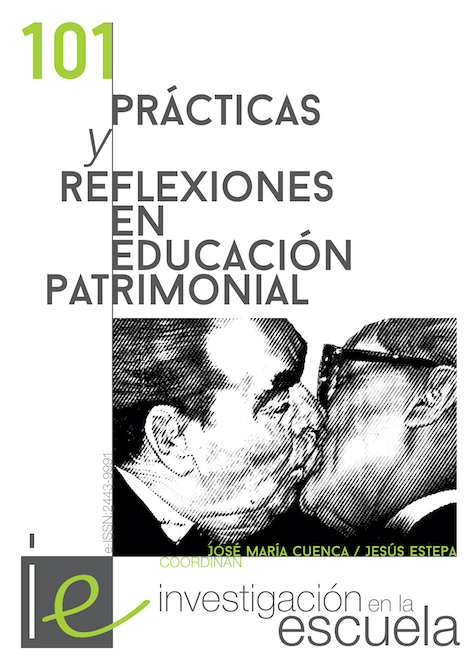Creencias sobre la relación escuela-museo: estudio prospectivo en la Facultad de Educación de Segovia
DOI:
https://doi.org/10.12795/IE.2020.i101.05Palabras clave:
Educación permanente, Didáctica del museo, Universidad, Patrimonio cultural, Museo, Educación no formal, Formación de profesores, CreenciaResumen
La relación entre la escuela y el museo es un tema ampliamente estudiado desde la perspectiva museológica. La escuela se ha establecido como primer hito de apertura del museo hacia la sociedad (Calaf, 2009), pasando desde una oferta formativa centrada en el currículo y supeditada a la estructura de la educación formal, hacia una perspectiva educativa propia que se sustenta en la educación no formal y se aleja del currículo. Sin embargo, apenas se encuentran estudios realizados analizando la visión de esta relación desde una perspectiva escolar. Se plantea pues el objeto de este estudio, queremos conocer qué creencias tienen los futuros maestros en torno a la relación actual entre la escuela y el museo. Nos centraremos en un estudio experimental contextualizado en el grado de Educación Infantil de la Facultad de Educación de Segovia, perteneciente a la Universidad de Valladolid, para ello se ha realizado una herramienta ad hoc para conocer las creencias del alumnado y se ha hecho una aproximación descriptiva a los resultados obtenidos. Los principales resultados nos acercan a la creencia de que en la relación escuela-museo las propuestas educativas deben partir del museo, adaptadas a los contenidos curriculares y que no existe flexibilidad en este tipo de propuesta y es el docente el que se debe adaptar a la oferta formativa ofrecida.
Descargas
Citas
Andrés, A. (2018). Un manifiesto en blanco para el museo y la escuela. Aula de Innovación Educativa, 272, 17-21.
Andrés, A. y García, E. (2018). Lo que está por venir: pasado, presente y futuro de las experiencias educativas entre museo y escuela. Revista padres y maestros, 375, 32-38.
Calaf, R. (2009). Didáctica del Patrimonio: Epistemología, metodología y estudio de casos. Trea.
Castro Calviño, L. y López Facal, R. (2019). Educación patrimonial: necesidades sentidas por el profesorado de infantil, primaria y secundaria. Revista interuniversitaria de formación del profesorado, 94, 97-114.
Cuenca, J. M. (2003). Análisis de Concepciones sobre la enseñanza del patrimonio en la educación obligatoria. Enseñanza de las ciencias sociales, 2, 37-45.
Defez, A. (2005). ¿Qué es una creencia? Logos, Anales del Seminario de Metafísica, 28, 199-221.
Díaz, C., Martínez, P., Roa, I. y Sanhueza, M.G. (2009). Los docentes en la sociedad actual: sus creencias y cogniciones pedagógicas respecto al proceso didáctico. Polis, 9(25), 421-436.
Escribano-Miralles, A., Polo-Espinosa, B. y Miralles-Martínez, P. (2019). Estudio de la opinión de los agentes educativos sobre las visitas escolares al Museo Arqueológico de Murcia. ENSAYOS, Revista de la Facultad de Educación de Albacete, 34(1), 101-119.
Feridouni, A. (2019). Nuevos espacios de aprendizaje. Incorporación adecuada de las TIC para tender puentes entre el museo y la escuela. Tesis Doctoral inédita. Universidad Autónoma de Madrid.
Fuentes, E. e Ingès, A. (2018). ¡La escuela y el museo hacemos un buen tándem! Transformamos la educación desde la colaboración. Aula de Innovación Educativa, 272, 22-27.
Garzón, A. (1989). Creencias, esquemas y acciones significativas del contexto social. En A. Rodríguez y J. Seoane (Coords.), Creencias, Actitudes y Valores (pp. 141-198). Alhambra.
Garzón, A. y Garcés, J. (1989). Hacia una conceptualización del valor. En A. Rodríguez y J. Seoane (Coords.), Creencias, Actitudes y Valores (pp. 365-403). Alhambra.
Hernández, L.A., Barneche, V. y Mihura, R. (2012). Mundos virtuales como canal de comunicación entre escuelas y museos. Estudios sobre el Mensaje Periodístico, (18), 509-518.
Lucas, L. Trabajo, M. y Borghi, B. (2020). El museo como laboratorio escolar: Análisis de buenas prácticas. Arte, Individuo y Sociedad, 32(2), 299-317.
Melgar M.F. y Donolo, D.S. (2011). Salir del aula… Aprender en otros contextos: Patrimonio natural, museos e internet. Revista Eureka sobre Enseñanza y Divulgación de las Ciencias, 8(3), 323-333.
Otzen, T. y Manteriola, C. (2017). Técnicas de muestreo sobre una población a estudio. Int. J. Morhol, 35(1), 227-232.
Rivière, H. (1993). La museología. Akal.
Suárez, M. Á. (2018). Museos y enseñanza de la Historia. Perspectivas del profesorado en Asturias. En A. Ponce y J. Ortuño (Eds.), Pensando el patrimonio: usos y recursos en el ámbito educativo (pp. 227-241). Editum.
Valenzuela-Valdivieso, E. (2012). La relación museo-escuela: verdad o utopía. Una propuesta para la asignatura de geografía. Investigación Universitaria Multidisciplinaria, 11, 7-16.
Descargas
Publicado
Cómo citar
Número
Sección
Licencia
Los autores/as que publiquen en esta revista aceptan las siguientes condiciones:
- Los autores/as conservan los derechos de autor y ceden a la revista el derecho de la primera publicación, con el trabajo registrado con una Licencia de Creative Commons Atribución-NoComercial-CompartirIgual 4.0 Internacional (CC BY-NC-SA 4.0), que permite a terceros utilizar lo publicado, siempre que se otorgue el adecuado reconocimiento; se mencione la autoría del trabajo y la primera publicación en AVANCES; no se haga uso del material con propósitos comerciales; y, en caso de crear otro material a partir del material original (por ejemplo, una traducción), debe distribuir su contribución bajo esta misma licencia del original.
- Los autores/as pueden realizar otros acuerdos contractuales independientes y adicionales para la distribución no exclusiva de la versión del artículo publicado en esta revista (p. ej., incluirlo en un repositorio institucional o publicarlo en un libro) siempre que indiquen claramente que el trabajo se publicó por primera vez en esta revista.
- Se permite y recomienda a los autores/as a publicar su trabajo en Internet (por ejemplo en páginas institucionales o personales) antes y durante el proceso de revisión y publicación, ya que puede conducir a intercambios productivos y a una mayor y más rápida difusión del trabajo publicado (vea The Effect of Open Access).


